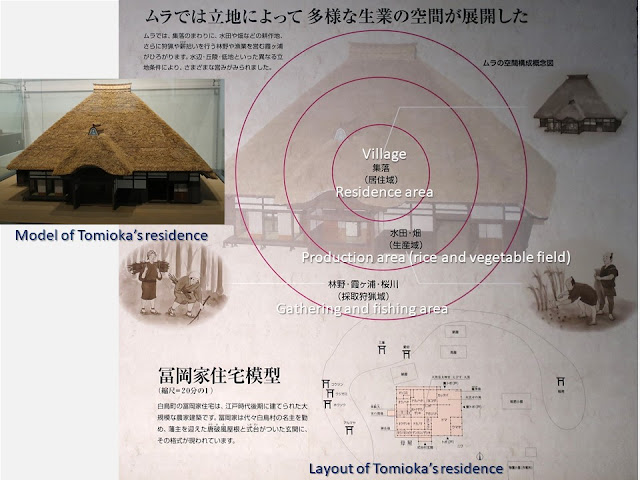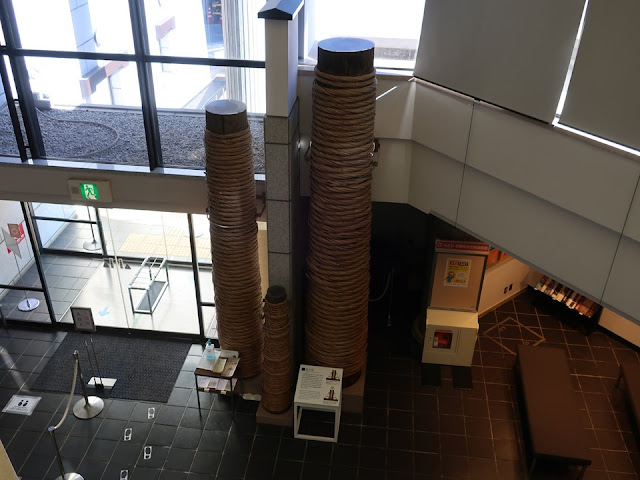Tsuchiura was a castle city and has been the center of transportation in Ibaraki Prefecture, which is around 70km northeast of the central Tokyo. The museum mainly focuses on history, so it’s not easy to find the fun things people used to do. However, there are photos of joyful people working togeher in the past.
中世から水陸の交通の要衝として発展してきた土浦。展示は歴史が中心で、庶民の楽しみには焦点を当ててしていません。でも、土浦で働く人々のいい写真がありました。
Medieval period、中世
The center of land and water transportation、土浦は水陸の物流拠点
Wealthy merchants, farmers, monks emerged in the medieval era. We can know their names and villages through the donation candidate note to a shrine in 1435.
中世には、商人、上層農民、寺院などの富裕層(富有人)が生まれました。鹿島社修繕の寄進者候補(1435)に富有人の名前と村、領主が書かれています。
Edo period (1603~1868)、近世
Tsuchiura was a castle city in the Edo period. It is introduced in details with the 1/100 scale model of Tsuchiura Castle and exhibits.
城下町になった土浦が亀城(土浦城)のジオラマ(1/100)と共に詳しく説明されています。
Commerce and brewing industry prospered, and it became the academic and entertainment center. There were four book stores back then. I’m sure people didn’t read only academic books, but they also enjoyed reading novels.
城下では商業、醸造業が発展し、学問や遊芸の中心地にもなりました。丁寧に説明されています。書店は4軒もありました。戦記物などで楽しんだと思います。
Several hundreds of horses were sold during a few days in the horse market at Tenmangu (shrine). Horse dealers and farmers gathered. It is written, “(the market) brought a large positive economic effect to the city”. It means people gathered and spent money for shopping or entertainments.
「馬市」では、数日間に数百頭の馬が取り引きされ、博労や農民が集まったとのこと。「町に大きな経済効果をもたらしました」とありますから、いろいろな遊びがあったはずですね。
The section “Towns and villages around the castle” shows me how people lived.
「城をとりまくマチとムラ」の展示では人々の暮らしを感じられました。
Towns developed around the castle. The model of Irokawa’s residence who run a pharmacy is displayed. What a rich merchant he was!
「マチ」は、土浦城を中心の発展していきました。「マチ」の代表は薬種業を営んでいた色川家。富裕人ですね。
The model of Tomioka’s residence is displayed as a representative of houses in a village. The family enshrines gods around the house. The number of the family members is decreasing, so it’s not easy to keep rites for gods; you can see the movies of rites. I guess it was a enjoyable for the master because many people including helpers used to join and make the rites cheerful.
一方、「ムラ」の代表は冨岡家。家の周りには神様を祀っています。その行事は、館内のビデオコーナーで紹介されていました。使用人がいなくなって、家族だけで暮らす今、しきたりを続けて行くことは大変だと思います。昔はワイワイガヤガヤで、主にとっては心地よいイベントだったと思います。
Modern period、近代
The development in the period is elaborated. Btw, the center of Tsuchiura was still the castle which was abandoned in 1873.
明治以降の町の発展も丁寧に説明されています。核は、土浦城跡でした。
The panel shows the transition of lifestyle since 1860. Some people on the photos looks vivid and happy.
「移りゆく景観と営み」のパネルには、1860年からの暮らしの変化を紹介しています。元気な人々の写真もありました。
In around 1940, women grilled and sold wakasagi (small fish) at roadside. It looks good; the smell seduces us. However, the cooking place changed to a factory because of hygiene reason. And electric ovens are used. Sanitation separated us from those women and ended conversation.
1940年頃 道路脇でワカサギを焼いていました。美味しそうですね。臭いに誘われます。衛生上の理由から、工場内での電気焼きに変わりました。衛生的にするためには、おばさん達との会話が犠牲になります。
Rice field in around 1965: It is written, “Before mechanization, people tackled rice planting and harvesting together, which were labor-intensive tasks“. Although women on the right are a bit nervous, they look happy. This shows good teamwork and cooperation.
1965年頃の田植の風景:「農作業が機械化される以前、人手を要する田植や稲刈りは共同で行われました」と書かれています。写真を意識している方もいますが、皆さん、楽しそうですね。協同して働くのは良いことだと思います。
Carp fishing at Kasumiga-ura lake which Tsuchiura faces, in around 1965
1965年頃、霞ヶ浦での鯉漁。
Firework equipment are exhibited at the entrance hall. Tsuchiura is famous for manufacturing of firework.
エントランスホールには花火の大筒が置かれています。花火作りで有名な街でもあります。
Belongings of Tsuchiya clan, who was a daimyo of Tsuchiura-han (local government), are exhibited on the 1st floor.
一階には、土浦藩の大名だった土屋家の品々が展示されています。
Those are classy indeed. さすがに良い品をお持ちです。
Tsuchiura city、土浦の街
The information center is an ex-merchant house.
蔵がある旧商家が案内所になっています
We can go to the second floor; it was a dry-goods store. It’s luxurious.
商家の二階も拝見できます。元は呉服屋の大徳さんでした。さすがです。
Visited
in November, 2021
Official
website: https://www.city.tsuchiura.lg.jp/page/dir000378.html (in Japanese), accessed in January,
2022
Previous
post (Museum in the same prefecture): Makabe
Denshokan Museum、真壁伝承館
Next post (Museum on the other kaidou / Nakasendou): Gyoda museum、行田市郷土博物館




















Comments
Post a Comment